| My pages about West Coast of Sweden |
| My travel stories | My photo impressions | ||
| Käringön, one of my favourite islands | Gullholmen | Ramsvikslandet | |
| Marstrand | Hälleviksstrand | Tresticklan NP | |
| Skaftö, hiking to lovely Grundsund | Härmansö | ||
| Stocken | Koster Islands | ||
| Mollösund |
The West Coast of Sweden
Marstrand

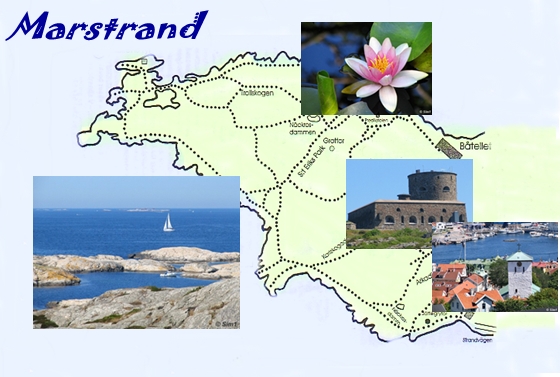
The little town of Marstrand is located on the West Coast of Sweden, just north of the city of Gothenburg (Göteborg). This village and island is a place that seems to attract the crowds and especially the ones that love sailing. But there is much more to Marstrand then only its harbour and of course the amazing amount of sailing boats. Marstrand seems to be a place that has it all: a cosy quay with colourful wooden houses, a fortress from the 17th century, wonderful rocky cliffs, a clear blue sea and views to die for. No wonder that it is loved and visited by so many people! But Marstrand also has a lesser discovered area, and that is a wonderful nature area on the backside of the island, which is well worth to explore!
Going to Marstrand

There are no cars allowed on Marstrandsön, so you better bring some comfortable shoes! That is if you want to explore a bit more of the island of course. The ferry arrives in the middle of the village, so exploring the village on foot is easy. The fortress on the other hand is a bit of a walk uphill, and requires a bit more effort. Besides a visit to the village and the fortress, I really can recommend a walk around the island: hence the pair of needed comfortable shoes.
The village of Marstrand is divided over two islands. Half of the village is located on the island of Koön, which has a connecting road to the mainland, and the other half (only 150 across the water) is located on the island of Marstrandsön. The most attractive part of the divided town of Marstrand is without a doubt the part that is on the island of Marstrandsön and that is what this page will be mainly about.
The only way to reach Marstrandsön is by boat or ferry, but it only takes a few minutes to cross: by the time you get on the ferry, you might as well start walking off again, because you are already arrived at Marstrandsön ;-) The ferry “Lasse-Maja” crosses over to the island many times a day. On average it crosses over every 15 minutes, but at night time approx. every half hour. So let's hop on board the ferry!
Just close your eyes for a minute and imagine a fresh salty sea breeze blowing through your hair, feel the warmth of the sun shining on your face, hear the sounds of seagulls in the distance and let me take you on a little virtual tour to Marstrand....
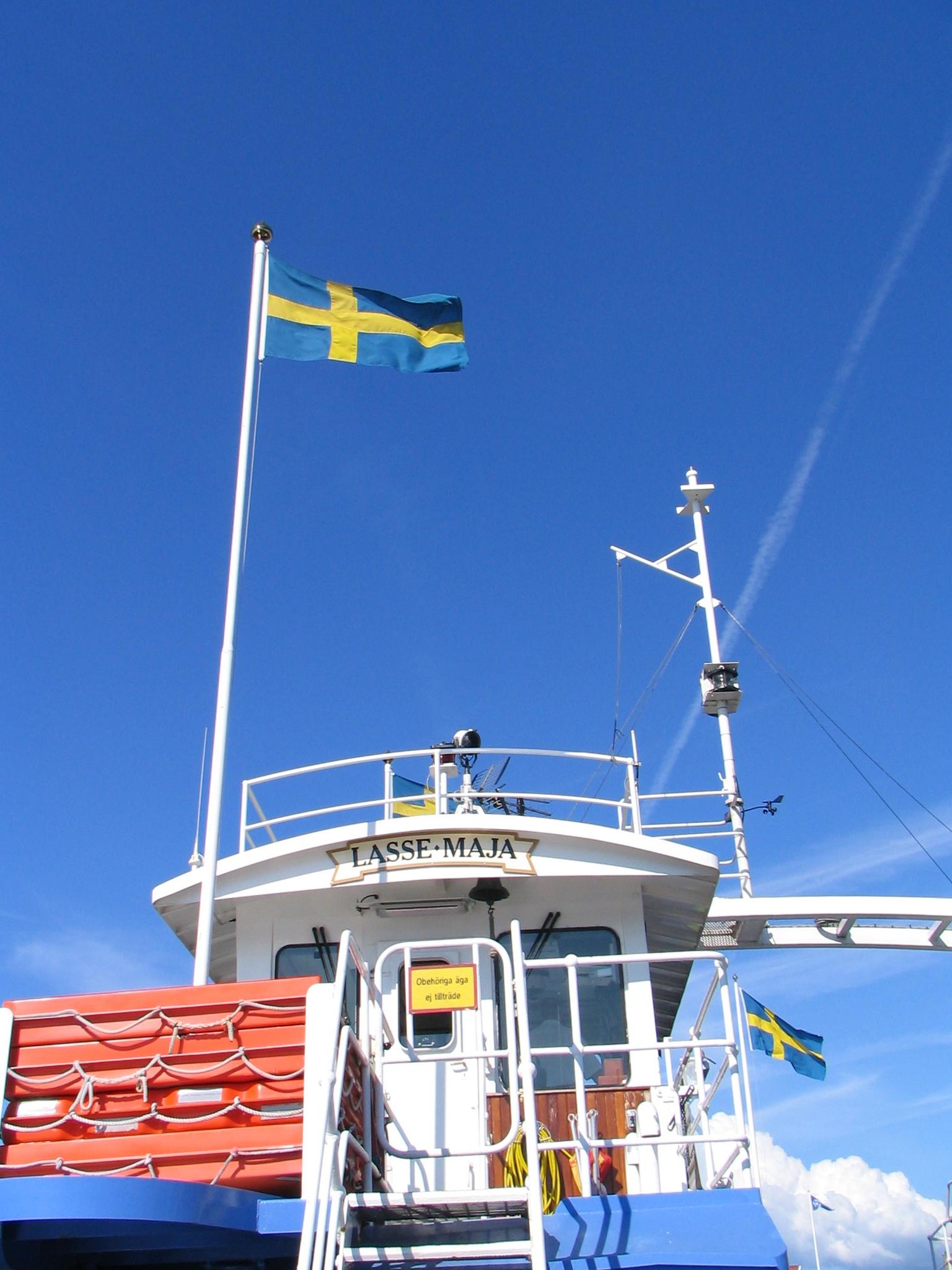
Sailing Marstrand

The harbour of Marstrand
The first thing you'll notice at Marstrand are the hundreds and hundreds of boats in the harbour.
The cheerful 'tinging' sound of the boats rocking on the mellow waves that come in from the sea; the sun reflecting from the white boats almost blinding to the eye, and the sun sparkling in the clear blue water, all these will make you wish you came here by sailing boat yourself! It must be perfect to go out to sea at this wonderful part of coast in Sweden. And well, that is what many people seem to do.
Some people consider the waters around Marstrand as one as the best places to sail in Sweden, and many classic sailing matches and regattas are organised here. The events range from small racing yachts to the Swedish Match cup. For current and upcoming activities and events I would suggest contacting the local tourist office at info.marstrand@kungalv.se
Södra Strandverket

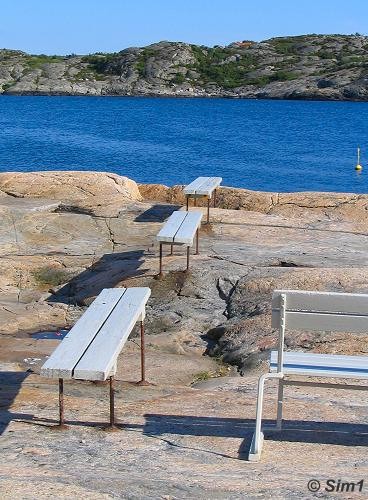
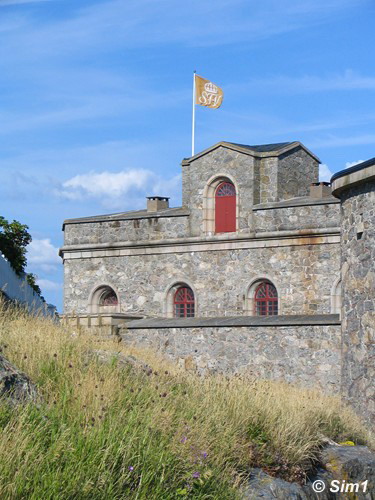
The ferry arrives in the middle of the quay, so your first choice upon arrival would be, do we go left or right? I opted for left and ended up at the end of the quay at "Södra Strandverket". It looks a little like a fortification, and as I like visiting historic places, it triggered my curiosity right away.
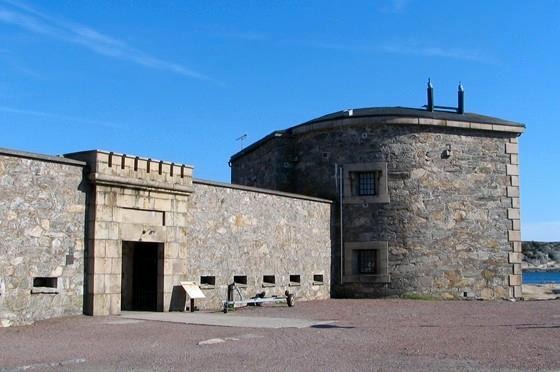
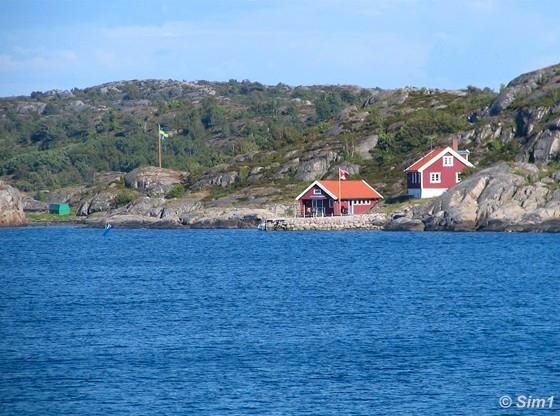
Södra Strandverket is indeed a fortification, but not nearly as old as I originally thought. It 'only' dates back to 1852 when it was build out of fear that Sweden would be drawn into the Crimean War. The war was over though before they managed to finish these fortifications.
Södra Strandverket was the last in the series of defence instalments at Marstrand, and at the time no less then 46 cannons and a garrison of 170 men were present in the fortification. Nowadays the building seems relatively empty, but it is still in use, although only for commercial purposes. There are rooms for conferences, but more interesting are the around 20 craftsmen that exhibit and sell their own work here. Outside the fortress there are some benches (photo 1) from where you can overlook the southern harbour entrance and the Albrektsunds Canal.
The quay

Although you probably are tempted to follow the trail from the Södra Strandverket fortifications (see previous tip) out off town and along the rocky shoreline of Marstrand, I would suggest you turn back first and follow the quay to the other end. This way you'll be able to look at the little village first, before exploring more of the island.
The quay in Marstrand is not a new addition to the town with the purpose to draw in the crowds. In the contrary, the quay was already build in the 1790's when it was (at that time) Europe's longest single quay of 1200 metres long. It looks quite charming with the old and colourful houses along the waterside. The quay is also Martstrand's busiest spot, which is not so surprising, as this is where you can find most restaurants and shops.
In the photo above you can see one of Marstrand's 'famous' buildings called "Turisten" but often better known after the name "Oscar". The house was build in 1897 and was in use as a hotel and restaurant.
The little church of Marstrand

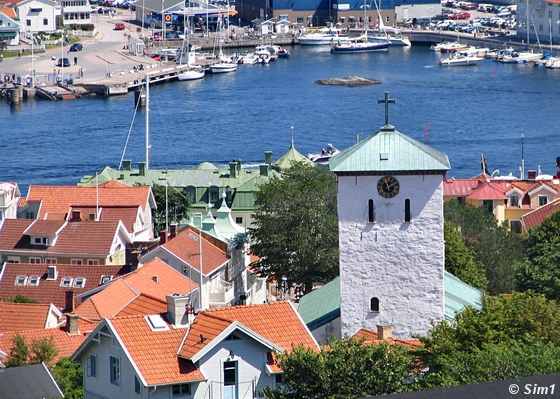
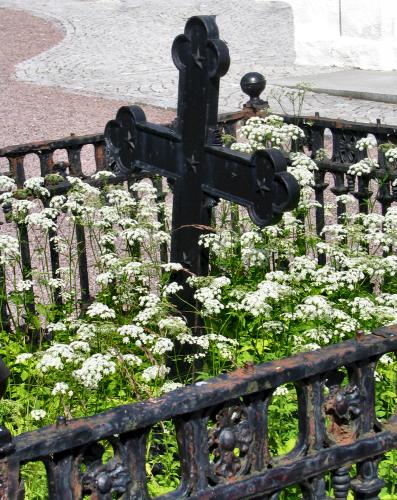
From the quay it is worth while to take one of the little side streets into the village as well. One place not to be missed is a visit to the little white church. You probably already seen it from a distance from the ferry, but it is nice to drop by here as well to take a closer look. The church and adjoining graveyard are very picturesque.
The church of Marstrand is the only remaining medieval building in Marstrand and dates back to the 13th century. The church belonged in those days to a Franciscan convent. The monastery however was destroyed during the 16th century, but the church survived. If you are lucky the church is open and you can have a look inside. Unfortunately we weren't that lucky and missed seeing the Triumph crucifix from the 14th century and a series of paintings, also said to be inside the church, all dating back to the 18th century. These 10 painting are also known as "The history of the heart".
The picturesque village

Marstrand is a picturesque little village with lots of colourful wooden houses. The houses are painted in soft tones, ranging from yellow, to light pink and pale green, and especially enjoyed all the wooden balconies. Most of the houses have been added in the 18th, 19th and also in the 20th century. The town itself however is much older, dating back to the middle ages. It is said that a church was build here as early as 1139, but the town itself was established in the 1200's. In those days the island of Marstrand belonged to Norway. Besides having been a Norwegian, it has also been under Danish rule, only to become Swedish after the peace agreement in Roskilde in 1658.
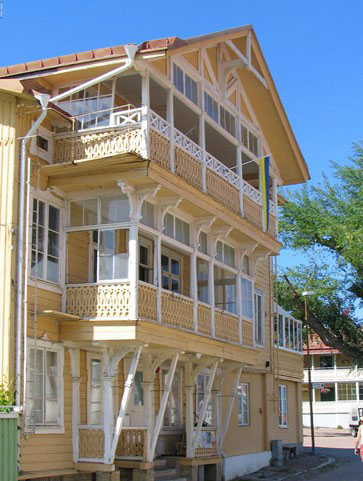
Maybe I should tell you a bit about Marstrands history as it has been quite a roller coaster ride. Having belonged to three different countries indicates a bit of Marstrand interesting past. In 1368 for example it was totally devastated by war, with the medieval fortress and the monastery burned down. But the town bounced back, mostly because of the herring. Herring, you might wonder, could that change history???
Well in the case of Marstrand, herring played a very important role in history. During the 1500's Marstrand became the centre of the European herring industry and remained this for several decades, bringing lots of prosperity to the town and also power. In 1588 however, Marstrand ran out of luck when the herring disappeared from the region. The town slowly faded away and was once again destroyed, but this time bye a great fire in 1643. In 1658 it became Swedish and a fortress was build (more about that later), it however stayed very poor until the 1700's. And yes, it was once again the herring that returned to the area and brought prosperity. And as history has a habit of repeating itself, yes, you can already guess it, the herring disappeared again, now in 1808. This time tourism came to the rescue when Marstrand slowly changed into a seaside bathing resort.
Put on your walking shoes....

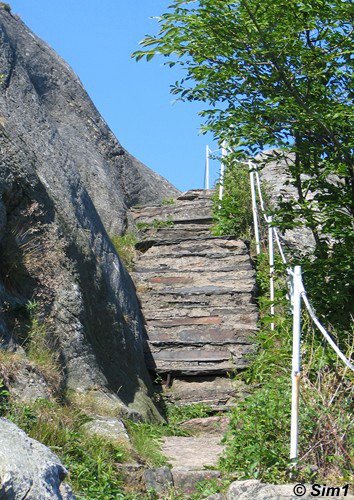
Time to leave history behind us and discover a bit more of the beauty of Marstrand. And to discover the beauty (in my opinion), you have to take the effort and walk a bit. And the walk would be mainly uphill!
On almost the highest point of the island you can visit the historical fortress called "Carlstens fästning". The tour of the fortress is very enjoyable and the views from the top of the tower over the island and surroundings are fantastic. And when you see this view, you will hopefully be inspired to walk a bit more around on the island as well. The western part of the island is the quiet part, as not that many people challenge themselves to discover this part of Marstrandön. You won't be disappointed though! The nature of the island is lovely, the views over the sea are wonderful and there is a nice hiking trail around the island to make for a lovely leisurely walk.
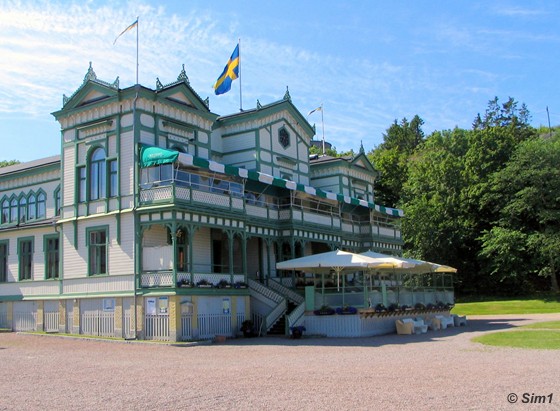
In photo on the left you can see the stairs that you need to climb at the beginning of the hike, which is located directly behind the "Societets huset". The Societetshuset, a social club, is quite an eye-cathing building. It dates back to 1886 when Marstrand was the favourite seaside resort of King Oscar II.
Narrow Passage

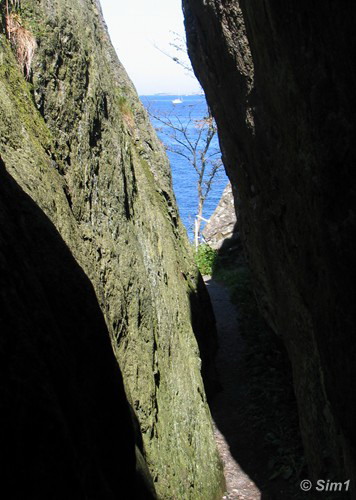
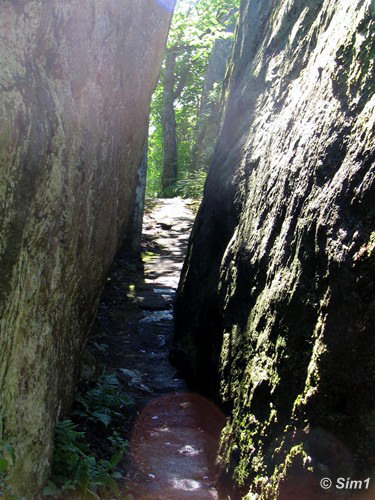
Very close to the beginning of the hiking trail on the north side of the island, you will pass a very narrow passage called "Nålsögat" or translated in English "the eye of the needle". This passage through the cliffs is just as narrow as it looks, and maybe even more narrow. As the rocks are all leaning to one side, you naturally start leaning yourself to the side to adjust to the shape of the rocks and get through the passage without a problem. From the warm sunny trail that is hugging the seaside, you will step into the cool shady and moist passage between the high cliffs. The passage isn't that long, so you will soon be welcomed again by the deep blue sea sparkling in the sun.
You can't really miss passing the "Nålsögat", just keep following the trail along the seaside and resist the temptation to go to the left to one of the trails that lead inland. If you do that you'll arrive at the "Eye of the Needle" after a short walk. On the map of the island (see beginning of the first page) you can get an overview of the many trails that cross the island. The Eye of the Needle is located approximately at the spot where the waterlilly photo is placed.
Rare red water lillies

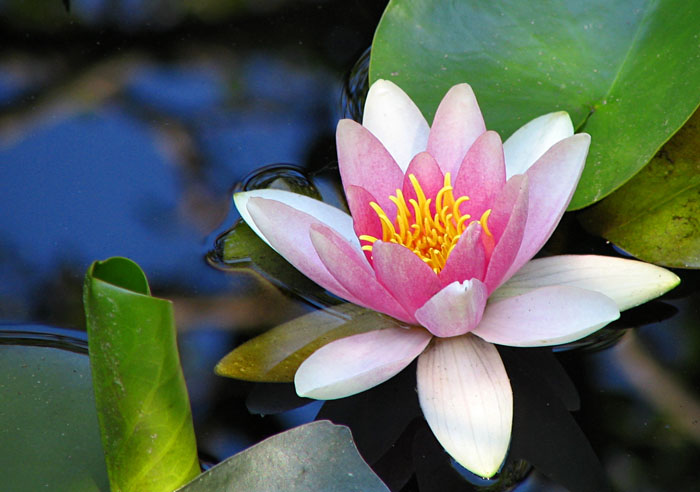
From the "Nålsögat" / "Eye of the Needle" it is only a short walk to get to the red water lily pond. The only main problem is that the signs along the trails aren't very clear or even totally missing. To get to the pond, you do need to get off the main trail along the seaside, and go land inwards.
On the downside: the lily pond is hard to find, even with the little map in my hand, I had a hard time locating it. But if you look on the bright side I have to say that the "Näckrosdammen", as it is called in Swedish (Water lily pond), is worth some extra effort as the flowers are stunning. Here you can see rare red water lilies in bloom. This part of the island is a bit more forested and nice and shady on a hot summer's day. Keep your ears open for the call of the frogs, which might help you find the water lily pond when you are on the wrong track.
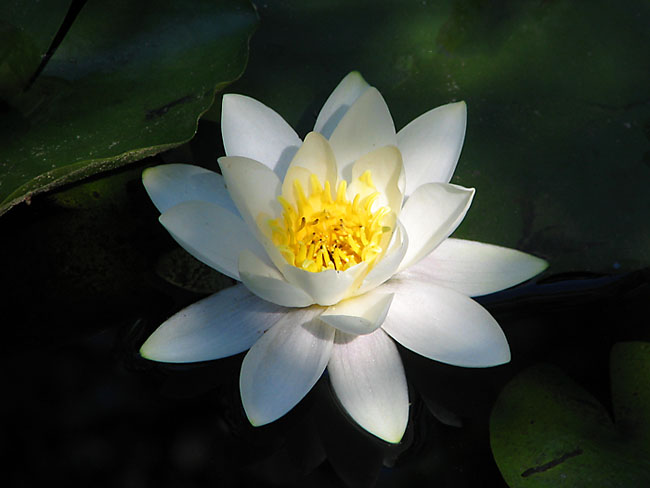
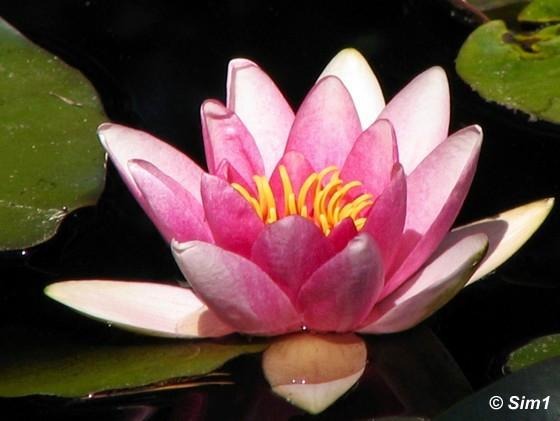
The amazing views


There are a few benches located on strategic places at the far end of the island (and actually also quite a few of those at the beginning of the hiking trail) giving you the opportunity to sit down and soak in the wonderful view.
To make your relaxing hike complete it might be fun to bring a picnic basket with you, or at least something to drink, as it can be very warm in the sun. There is nothing better then to sit here, feel the warmth of the sunshine on your face, feel the cool salty sea breeze, and soak in the views. Together with a little snack and drink it is just perfect! I could have sat here for hours and hours :-)
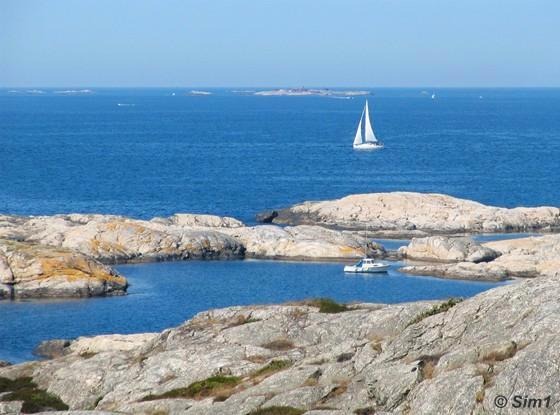
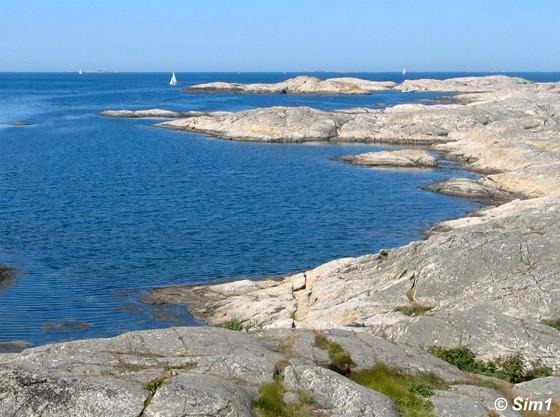
Wild Honeysuckle

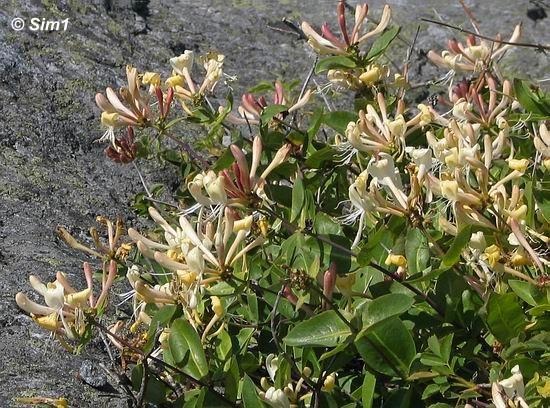
Marstrand wouldn't be Marstrand without it abundance of Wild Honeysuckle. Especially at the tip of the island, the grey rocks are covered by this wild climber.
The "Lonicera periclymenum" or also known as the Common Honeysuckle, European Honeysuckle or woodbine is an enthusiastic climber that can grow up to 10 meters high. In this case it would be long as the plants crawls over the rocky surface instead of climbing up in the air. The Wild Honeysuckle is native to much of Europe, and it does grow in Sweden as well, although it is only native in the south of Sweden, and mainly along the coastline. The flowers are creamy white almost turning towards yellow and the smell is very, very sweet. The perfume takes over the whole area and is almost hypnotizing, hahaha, if you can say that of a smell. Anyway, it is fantastic to walk through these "fields" of honeysuckle, giving life, colour and aroma to the rocky grey coastline. Oh yes, to see the honeysuckle in bloom you need to be here during the months of July and August. The sweet smell of the honeysuckle is at its strongest during the evening hours.
Carlsten Fortress

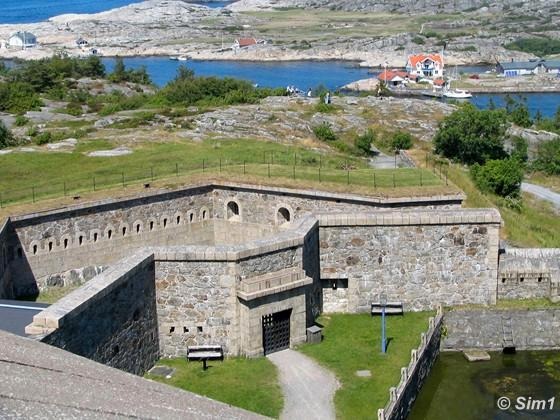
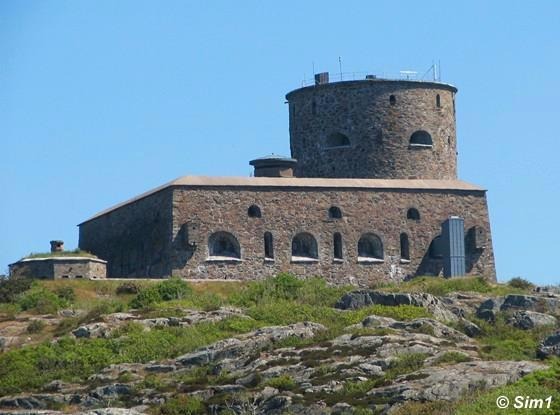
Time to leave the peace and quiet behind and walk towards the main attraction of Marstrand: Carlsten Fortress. This fortress is located on the highest point of the island and can been seen from far away and also from almost any point on the island.
The history of the fort is quite interesting and long. It all started in 1658 when the peace agreement of Roskilde was signed. This was the year that Marstrand and the rest of the region "Bohuslän" became Swedish. As I already mentioned, Marstrand was wealthy because of its fishing and trading. What I haven't mentioned yet is that Marstrand was also a navel base. In order to defend Marstrand, King Carl Gustav X decided to build the Carlsten Fortress.
As most fortresses, this one wasn't build overnight, it slowly progressed into what it is now. They started off with a square tower and a small courtyard surrounded by walls. Of course they quickly discovered that wasn't sufficient enough, so the square tower changed into a stronger higher and round one. The walls were also raised in height. But again, new additions were neede4d during the 1700' and 1800', when the outer sections were built. Finally in 1860 the fort was declared complete. It is quite interesting to visit Carlstens Fortress, so I can really recommend it!
Try to join a guided tour as these are great, although having said that, I think they are only in Swedish. To make sure I would recommend contacting the fortress: info@carlsten.se. Head sets with English guiding are available; signs at the fortress are both in English and Swedish.
Directions: Walk to the right along the docks. After about 200 metres, turn left into “Kungsgatan”. Follow that street (steep hill) until you reach the fortress. Once up the hill, turn right, pass the bulletin board and keep walking until you reach a gate “PORT 23”
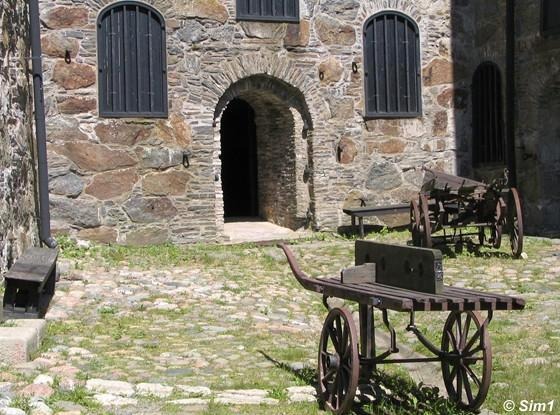
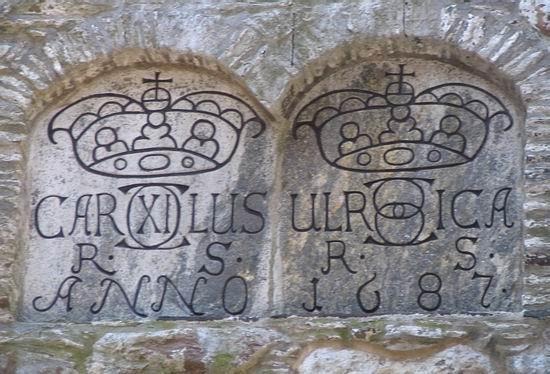
About the soldiers and their prisoners

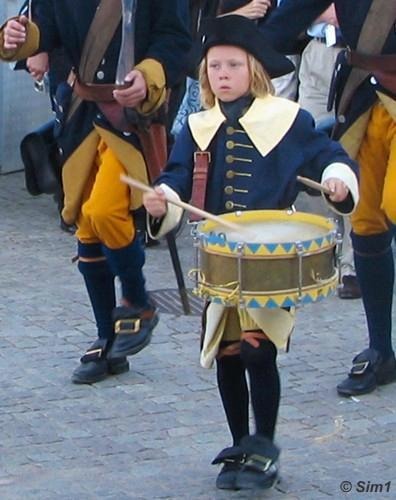
If you visit Marstrand during the month of July, you might run into this little drummer boy and the rest of the group of Karolinian soldiers. During the "The historical days", which are held at the end of July, these soldiers perform both inside the fortress and down in the city of Marstrand. The fort wasn't build by the soldiers though; they used the help of prisoners to do so.
Building Carlsten Fortress was a huge job. Think about climbing up the hill to the fortress without carrying anything with you (and I can promise you that you already will feel that in your legs!). And now please imagine doing so with one of those large stones needed to build the fortress. An inhuman task! So 'creative' as they were during those days and in desperate need of 'employees', they invented a new punishment in Swedish law called "Marstrand work". This gave them the excuse to transport criminals from all over the country to Marstrand to have them build the fortress for them. These were murderers, thieves, forgers and rapist, but also petty criminals didn't escape this horrible sentence. These prisoners could get stuck here at Marstrand for several years to even life. Besides the heavy stones they also had to bare with them a two-kilo iron ball and chain fastened to their leg, to prevent them from escaping.
Inside the fortress you can take a look at the prison cells and also here stories about what it was like to live inside the fortress during those days. You can find more info regarding opening hours and admission fee on their website
Lasse Maja


The name you will see and with almost every step you take at the Fortress, and also in Marstrand itself, is "Lasse Maja". Even the ferry towards the island is called the "Lasse Maja"!
"Lasse Maja" is an interesting figure giving lots of colour and life to the history of Carlstens Fortress. So it is not that surprising that Carlsten and Lasse Maja are often named in one sentence. His real name was actually Lars Larsson, a successful thief who was able to avoid being captured for a very long time. His trick was to dress as a woman and apparently he was very good at it as he even managed to escape the fortress once using this trick ("Maja" is a female name in Swedish). He wasn't able to enjoy his new found freedom long though, as he was soon after captured again.
Lasse Maja landed in prison in 1813 and started off, like all prisoners, dragging up the stones to the fortress. However he was soon discovered to be a good cook, a skill he had learned by disguising as a woman for so many years, so he was dismissed from the worst of the work and got the privilege to work in the kitchen instead. He had kitchen duty during most of his stay at Carlsten, only to be pardoned by King Karl Johan XIV after 26 long years of imprisonment.
You can hear these, and many other interesting stories, during the guided tour around the fortress. Of course if you don't have time to join the guided tour, you can discover the fortress at your own pace as well.
Climb the tower!

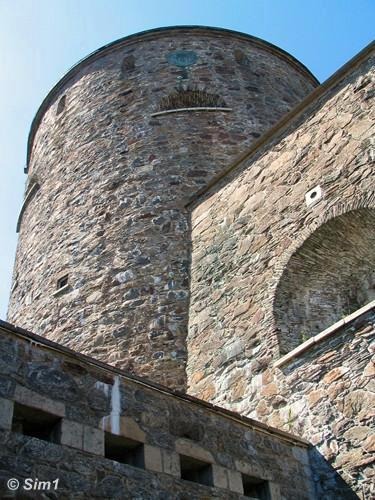
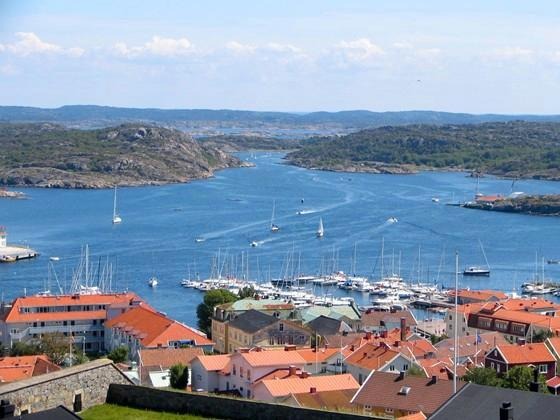
The guided tour doesn't go here, but that doesn't mean that it is not worth while doing. If you have the time and the energy (yes, it is quite a few steps up to reach the top of the tower!), you certainly should go up here. The views over the island are the best!
You can look down on the village of Marstrand with its cute white church tower. See the sailing boats going in and out of the harbour, see towards the mainland, and on the other side of the tower, see many more little islands scattered around like little dots in the clear blue sea surrounding Marstrand. On a sunny day like this it is a joy to stand here and just take in the wonderful views.
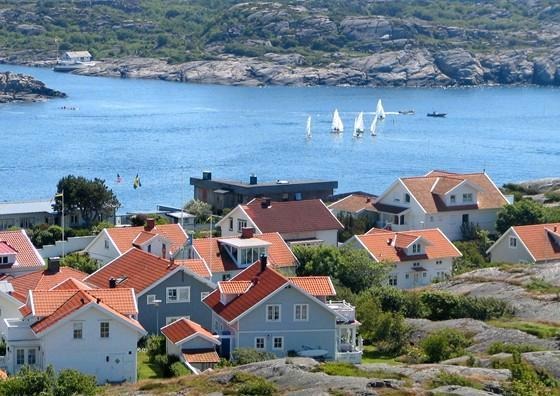
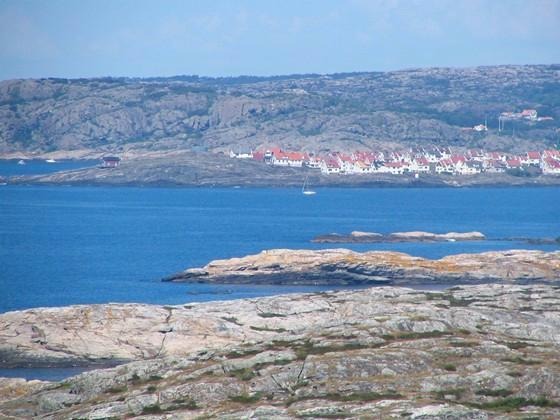
Delicious and fresh seafood

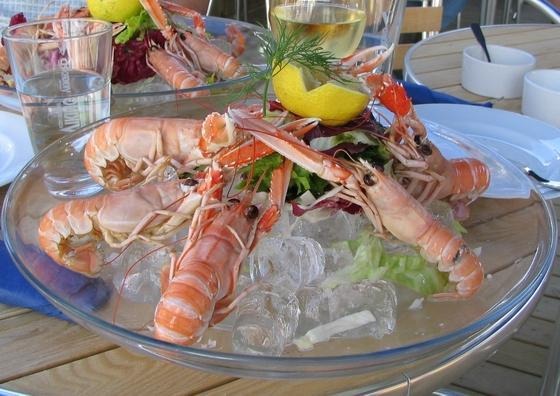
To finish off our perfect day att Marstrand, we had dinner at one of the restaurants located at the quay of Marstrand. The place was a perfect and relaxing dinner spot! When on the west coast of Sweden and this certainly applies to Marstrand, the thing to eat is fish! They have lots to choose from and it is all fresh from the sea. Of course we couldn't resist that temptation and we opted for the "kokta Havskräftor".
These are cooked Norway lobsters (Nephrops norvegicus) or also called Dublin Bay prawn or langoustine. The Havskräftor were served on a bed of ice, accompanied by a great tasting salad and a glass of white wine, which was chilled to perfection. Aaah, my mouth starts to water again thinking back to this delicious meal. It is so simple, but yet so exquisite! Sitting outside on the terrace in the late afternoon sun, having views out over the harbour, joined by wonderful company and of course this delicious meal, it was a dinner to remember.